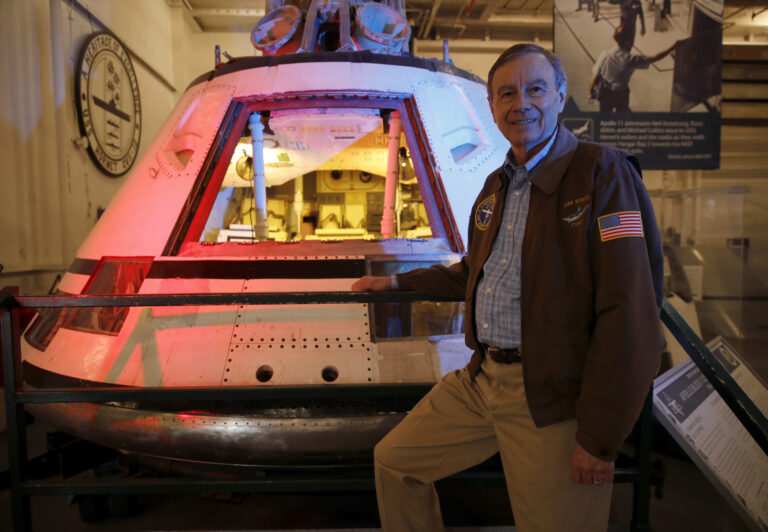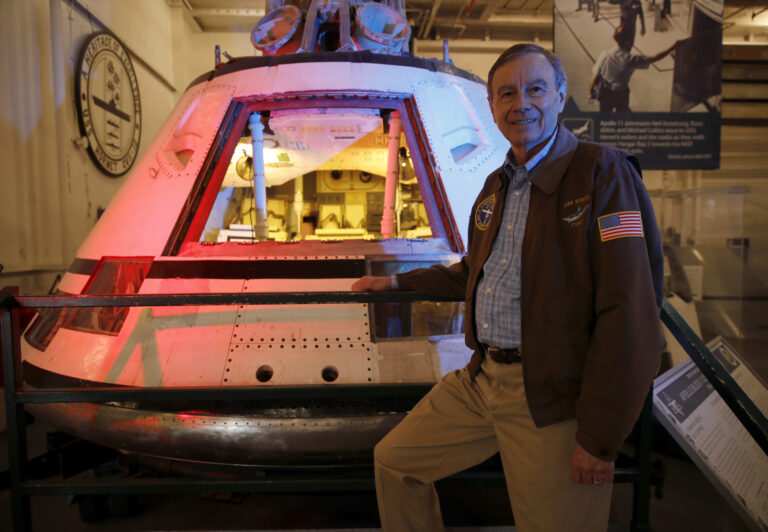
It is a lesser-known note in history that Neil Armstrong’s first words back on Earth after exiting the Apollo 11 space capsule were: “Bzerblizerblz.”
It was July 24, 1969, and Armstrong and his fellow astronauts had just splashed down in the Pacific after becoming the first humans to walk on the moon. While their capsule pitched in the waves, the astronauts slipped on biological isolation garments – bulging, full-body suits meant to prevent the spread of lunar pathogens.
“So I’m standing there, and the first person who comes out turns out to be Neil Armstrong,” says Clancy Hatleberg, officer in charge of the swimmer-recovery teams of Apollo 11. “He sticks his hand out and says something. Now with the gas masks, you can’t understand anything. So I fell back on my Navy training, which is when you’re in an operation, and somebody says something to you, you repeat it back to let them know you understood. I said back into the face mask exactly what I heard, ‘Bzerblizerblz.’”
Today, space enthusiasts can enjoy a bit of that history by visiting the USS Hornet Museum in Alameda. The Essex-class aircraft carrier, which saw combat in WWII and Vietnam, was the recovery vessel for the Apollo 11 and 12 missions. Visitors can explore its gargantuan guts and an exhibit devoted to the Hornet’s role in the space race. In the collection is a capsule that NASA shot up to test a heat shield, a helicopter that recovered astronauts and a Mobile Quarantine Facility (at $250,000, the world’s most expensive Airstream trailer) that astronauts stayed in before being deemed free of moon germs.
The man responsible for much of the museum’s current holdings is trustee Bob Fish, former chief historian for the Hornet’s two Apollo recoveries. The former Marine’s fascination with space was instilled during a childhood spent near Cape Canaveral.
“We’d be in school, the fire alarm would go off, and we’d all rush out to the football field and watch the old Gemini and Mercury and a couple of the Apollo launches,” says Fish, who lives in Danville.
Fish has spent the past couple of decades tracking down space paraphernalia both small and large. He found the museum’s Sea King helicopter in a boneyard near Tucson, Arizona, for example, and verified its flight history via serial number. The helo was used in the Gemini 4 mission, which featured the first-ever spacewalk, and Ron Howard later borrowed it as a prop in 1995’s “Apollo 13.” But the aircraft carrier itself is the largest remaining artifact from this key part of the Apollo missions, and the bulk of the museum focuses on the recovery process for Apollo 11 and 12 astronauts.
“John F. Kennedy, in a speech in 1961, said to land humans on the moon and return them safely to the Earth,” Fish says. “We — the Hornet — were the people who returned them safely to the Earth and the United States of America.”
In 1969, the Hornet was in between assignments in Vietnam and sort of puttering around the Pacific Ocean. Aircraft carriers were the vessels of choice in these missions, because they had rotary-wing and fixed-wing aircraft capabilities and cranes capable of lifting space capsules, as well as medical facilities, in case there were injuries. They also were a sizable military deterrent. According to maritime law, a craft operating in the water without power (like a space capsule) can be recovered by anybody. And at the time, Soviet trawlers were prowling the area.
Astronaut recovery during Apollo 11 was like a highly choreographed fishing trip, albeit one involving high-stakes re-entry calculations and weather concerns. In this case, a big storm had hit the planned landing area, and it had to be moved 240 miles toward Hawaii.
“All night, the Hornet was steaming at full speed, and then finally, as the sun was starting to come up, they pulled out their sextants – which have been used for thousands of years – and took a star sighting. They said, ‘We’re there,’” says Fish. “They cut the engines off and just waited. About an hour later, there was a huge sonic boom, and the command module came down out of the sky.”
The jolt was so strong when the capsule hit the ocean, it knocked Buzz Aldrin’s hand off the parachute-cutting switch. The capsule landed awkwardly, with the astronauts hanging upside down from straps, until the vessel righted itself.
Then began the decontamination. At the time, scientists didn’t know if harmful germs were lurking in the lunar soil. The thinking was, if pathogens could live up there without oxygen, they could be deadly here on Earth. And the astronauts were covered in the dark, sticky stuff of lunar soil – it was all over the capsule and in their lungs – so they were treated like they were radioactive. (If you’ve ever wondered what lunar soil smells like: “Burnt ashes,” says Fish.)
The astronauts were whisked to the Hornet and stuffed into a modified Airstream trailer called the Mobile Quarantine Facility, which was then loaded onto an airplane and flown to NASA in Houston. There’s a famous photo of Richard Nixon on the deck of the Hornet, peering into the trailer and welcoming the quarantined astronauts back to Earth with a wide grin. The USS Hornet Museum has re-created the scene, with the trailer and all the equipment in the same place.
The astronauts stayed in quarantine for a couple of weeks. “Basically, we had to do it until we could prove there were no pathogens on the moon that could come back and start a plague,” Fish says. “Neil said he actually enjoyed it. It kept the media and all the gawkers away, so they could decompress a little bit and write all their thoughts down.”
Meanwhile, Hatleberg had a hand in the capsule decontamination. “We had two fire extinguishers that were filled with decontamination fluid, one with bleach and the other filled with Betadine, a surgical scrub,” he says. “Then they gave me a really high tech device — a car mitt — that I used to wash down the astronauts. After that was done, I sank (all the equipment) to the bottom of the Pacific.”
It was then that Hatleberg had his momentous but indecipherable conversation with Neil Armstrong. The astronaut passed away in 2012, so we’ll never know for sure what he said, but Hatleberg has an idea.
“Knowing Neil, he was an ordinary, humble guy,” he says. “So I’m thinking, it was just what he would have said to me on the street: ‘Hey Clancy, good to see you again!’”
Details: The USS Hornet Sea, Air & Space Museum ($10-$20) is open from 10 a.m. to 5 p.m. Friday-Monday at 707 W. Hornet Ave, Alameda; https://uss-hornet.org/.
___
© 2024 MediaNews Group, Inc
Distributed by Tribune Content Agency, LLC.
American Military News Rephrased By: InfoArmed
